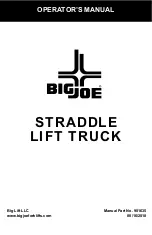
Maintenance
49
a. Platform up button b. Drive function select button
4. Press function button
5. Raise the platform approximately 2 m
from the ground.
6. Press drive function select button
7. Choose a point on the machine; i.e.,
contact patch of a tire, as a visual reference
for use when crossing the start and finish
lines.
8. Move the control handle to drive at the
maximum speed. Begin timing when the
reference points crosses the start line.
9. Continue at full speed and note the time
when your reference point on the machine
passes the finish line. Refer to specification.
B-10
Test the Drive Speed-Platform
Stowed, Slow
This procedure should be performed every
250 hours or quarterly, whichever comes first.
Proper drive functions are essential to safe
machine operation. The drive function should
respond quickly and smoothly to operator
control. Drive performance should also be free
of hesitation, jerking and unusual noise over
the entire proportionally controlled speed
range.
Perform this procedure with the machine on a
firm, level surface that is free of obstructions.
1. Create start and finish lines by marking
two lines on the ground 40 feet/12.2 m apart.
2. Turn the key switch to platform control
and pull out the red Emergency Stop button to
the on position at both the ground and
platform controls.
3. Lower the platform to the stowed position.
4. Press the drive speed select button
a. drive speed select button
5. Choose a point on the machine; i.e., contact
patch of a tire, as a visual reference for use
when crossing the test line.
6. Move the control handle to drive at the
maximum speed. Begin timing when the
reference points crosses the start line.
7. Continue at full speed and note the time
when your reference point on the machine
passes the finish line. More than 25S
B-11
Perform Hydraulic Oil Analysis
This procedure should be performed every
250 hours or quarterly, whichever comes first.
Replacement or testing of the hydraulic oil is
essential for good machine performance and
service life. Dirty oil may cause the machine to
perform poorly, and continued use may cause
component
damage.
Extremely
dirty
conditions may require oil changes to be
performed more often.
Before replacing the hydraulic oil, the oil may
be tested by an oil distributor for specific levels
of contamination to verify that changing the oil
is necessary.
If the hydraulic oil is not replaced at the
two-year inspection, test the oil quarterly.
Replace the oil when it fails the test.
Refer to E-1 Test or Replace the Hydraulic oil.
B-12
Summary of Contents for ES100E
Page 5: ...Decals 3 ...
Page 7: ...Decals 5 ...
Page 9: ...Decals 7 ...
Page 59: ...Electrical Schematic Diagram 57 ES40E ...
Page 60: ...Electrical Schematic Diagram 58 ES60E ES80E ES100E ES120E ...
Page 62: ...Hydraulic Schematic Diagram 60 ES80E Y7 Y7 G1 4 19 Y1 Y1 Y2 Y2 Y3 Y3 Y4 Y4 Y5 Y5 Y6 Y6 ...
Page 64: ...Hydraulic Schematic Diagram 62 Maintenance Record Date Note ...
Page 65: ......















































